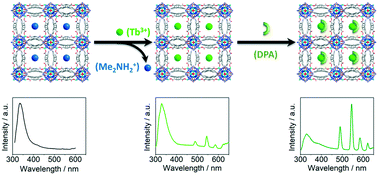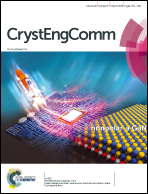A lanthanide functionalized MOF hybrid for ratiometric luminescence detection of an anthrax biomarker†
Abstract
Dipicolinic acid (DPA) can serve as a convenient biomarker for Bacillus anthracis, which is an extremely hazardous pathogen and can be used as a biological weapon. Herein, we demonstrate a ratiometric luminescent sensor of DPA based on a dual-emissive MOF hybrid, which is developed by encapsulation of Tb3+ cations into an anionic MOF through a cation exchange process. The Tb3+@MOF hybrid well inherits the intrinsic ligand emission of the host framework and the Tb3+ emission. The parent framework can function as a host matrix to sensitize and protect the emission of incorporated Tb3+. The Tb3+ emission within the MOF hybrid is significantly enhanced in the presence of DPA molecules owing to the occurrence of antenna sensitization upon the formation of the Tb–DPA complex, while the ligand emission is insensitive to DPA. This unique ratiometric luminescence response of the Tb3+@MOF hybrid towards DPA can be exploited for sensitive self-calibrated detection of DPA. The Tb3+@MOF sensor shows a fast response rate, high sensitivity and selectivity with a limit of detection of 3.6 nM. Besides, the feasibility of this sensor operating in real samples is demonstrated by the good recovery of DPA in human serum. The present study provides a promising luminescent platform for routine analysis of an anthrax biomarker.

- This article is part of the themed collection: Editor’s Collection: Bio-applications of MOFs


 Please wait while we load your content...
Please wait while we load your content...